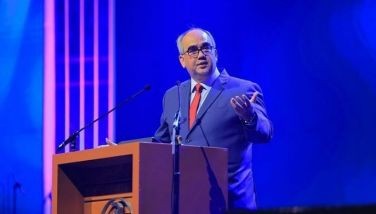Who owes what to whom
A couple of weeks ago, an unattributed article in another newspaper titled “National artists owe it all to Marcos” berated five National Artists – Bencab, Virgilio Almario, Alice Reyes, Ramon Santos and Ryan Cayabyab – for proclaiming their support for VP Leni Robredo’s presidential bid. They were, said the unnamed writer, ingrates for forgetting the fact that the National Artist Award had been created by Ferdinand Marcos, implying further that they owed their fame and fortune to Manong Ferdie, without whose patronage they would be nobodies hawking their wares at streetcorners. “Prior to his being named national artist in 2006, Cabrera was not as well known as he is today in the national art scene. Today, his paintings sell in the millions of pesos.”
That’s odd because as far as I knew, Bencab, along with the others, was already famous within and outside Philippine artistic circles well before he was proclaimed National Artist. In fact, didn’t he become one because of his impressive body of work? Or did I get it wrong? According to that article, it was the NA Award that made these people, and since Manong Ferdie established it, then, well, they were forever indebted to him for their professional success. That should go as well for such luminaries as Jose Garcia Villa, Vicente Manansala, Amado Hernandez, F. Sionil Jose, Jovita Fuentes and Atang de la Rama, among many others.
The article dutifully reminded the reader that “To recall, on 27 April 1972, President Ferdinand Marcos issued Proclamation 1001 creating the Order of National Artist of the Philippines, to recognize outstanding Filipino artists. Under the Marcos proclamation, a national artist is entitled to a cash award of P100,000, a handsome monthly stipend, yearly medical and hospitalization benefits, life insurance coverage, a place of honor in state functions and national cultural events, a state funeral and burial space at the Libingan ng mga Bayani.”
Wrong. There were no such benefits under that proclamation, only the honorific title. (Go on, look it up.) The emoluments came later, in the form of the aforementioned one-time cash award and a P2,000 monthly stipend, raised much later to P10,000 and then P50,000 (on the government pay scale, equal to about Salary Grade 19, just one grade above sub-professional supervisors). Since National Artists typically get chosen in their 70s or even posthumously, that’s not much of an outlay.
I would have been more enthralled by Manong Ferdie’s magnanimity if it had been his personal finances that paid for the package. But that was always the people’s money. And even his personal finances had a way of being traced back to some public source.
Where else did our taxes go? Why, to the recipients of the CCP International Artist Award, which I’ll bet most of us never even heard of. The book Musical Renderings of the Philippine Nation by Christi-Anne Castro (Oxford University Press, 2011) chronicles how the First Lady instituted this award – which came with an unspecified life pension for such laureates as Van Cliburn and Margot Fonteyn – in June 1973 “as a personal gift from Imelda Marcos as well as a small incentive for international performers to make the long journey to the Philippines to perform at the CCP.”
The article chides “anti-Marcos” creatives for dreaming of becoming National Artists and for accepting its conferment. But since when did the award – or any credible award for that matter – require fealty to its originator or sponsor? Were the victors at the 1936 Berlin Olympics expected to genuflect before Hitler? Should Nobel Prize winners espouse arms sales, as Alfred Nobel once did?
I don’t dispute the claim that the Marcoses supported the arts and culture through the creation of the Cultural Center of the Philippines, the Folk Arts Theater and the Manila Film Center, as controversial as they were (and in the case of the Film Center, as tragically ghoulish, with as many as 169 workers’ bodies reportedly entombed in the concrete). Favored artists were set for life.
But cultural patronage is a PR expense. The art shows decorated and sanitized the regime, and made it appear to whoever cared to look that the Philippines was one big, colorful, glittery stage. For the National Artist Award to be taken seriously, they had to recognize serious artists – even those who weren’t Palace toadies, like Nick Joaquin (who accepted the award in 1976 only on condition that his friend the journalist Pete Lacaba, then in prison after being brutally tortured, be set free). After the Marcoses, the NAA was revived and expanded – the National Scientist and National Social Scientist Awards were also established – but it never quite shook off the stigma of political favoritism. Most notably, in 2009, Gloria Macapagal-Arroyo played dagdag-bawas and anointed four of her personal choices NAs, prompting a suit from the real NAs and many other petitioners, which ultimately prevailed.
If you want to get political about utang na loob, even Rodrigo Duterte acknowledges that it was Cory Aquino who jumpstarted his political career when she appointed him OIC mayor of Davao after EDSA 1 when his mother “Nanay Soling” – among the few staunch anti-Marcos activists in Davao – declined the offer. He later said in an interview that he was not going to dishonor his mother’s memory “by following the persons that she helped shut down.” But then in 2016, against widespread opposition, he allowed Ferdinand Marcos to be interred as a hero. That should have earned him a cache of pogi points with the Marcoses, who then jumped the gun on Inday Sara’s own presidential ambitions – or whatever Tatay Digong had in mind for her – by pushing Junior for No. 1. Of course, my pro-Sara friends (I do keep a handful, for our mutual entertainment) insist that Sara is going her own way and isn’t answerable to her dad. So this puzzle of who-owes-what-to-whom gets more and more difficult to figure out. Does it even matter in Pinoy politics?
And if we’re serious about debt collection, how about the P125 billion in ill-gotten Marcos wealth that the Philippine government still has forthcoming? Sounds more like the Marcoses owe it all to the Filipino people.
* * *
Email me at jose@dalisay.ph and visit my blog at www.penmanila.ph.
- Latest
- Trending
























